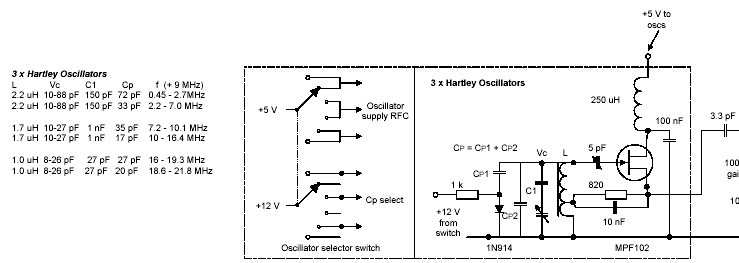


|
All the comments in quotations are Duncan Watson's, and are the contents of emails that we swapped during the designing of his SWL receiver. For more detail download the Electroluminescent.pdf file. "Three separate Hartley oscillators, each using a different section of the tuning capacitor. Each Hartley oscillator diode switched with a single parallel capacitor, to create 6 switched frequency ranges covering: a) 0.5 to 2.7 MHz c) 6.8 - 10.1 MHz e) 16 - 18.8 MHz "Frequency stability is not good enough for amateur usage, but okay for me tuning across the band listening to short wave stations. "Originally I had hoped to use a single bandswitched Hartley oscillator, but this proved to be too hard - even switching relays and/or diode switching introduced too much capacitance. "I've got a reduction drive on the tuning cap, and tuning in SW stations is okay - a 4 MHz tuning range is okay." |
|
My comments: Another place to look to solve this problem is at the mixer injection level at the first VFO amplifier. A 100K variable pot (Black color) is used to fine tune the injection levels to the first mixer, and can eliminate a lot of problems, especially with birdies, AGC working properly, etc. It is so important that on the next set of boards, I have put a hole on the upper board so that it can be accessed easily for adjustment. "I'll have a look at this too. With 3 oscillators and the wide coverage I have (oscillator frequencies from 9.5 MHz to 31 MHz), the output does vary. The LEDs are useful for this. Maybe I'll bring the pot out as an adjustable control to the front panel." |
|
"I've installed a small fine-tuning control using an 1N4004 diode as a varactor in the source tap of the 3 Hartley oscillators. "Putting the additional capacitance in there has almost no effect on the tuning ranges, and the values chosen gives me 10 - 30 kHz fine-tune over the different oscillator ranges. "The oscillators still seem pretty stable - I've watched drift over several minutes and it would be 20 - 30 Hz. (The Hartley oscillators I'm using I'd expect to be much less stable than the Vackar design you used). "You may notice I haven't used the Huff-n-Puff frequency stabiliser. Still sitting made up, but not implemented. Bit difficult with three oscillators, so haven't decided what to do here yet." |
Send E-Mail || Amateur Radio Receivers || Electoluminescent Receiver || Duncan Watson's SWL Receiver || Duncan Watson's SWL Receiver Details || Gary Rondeau's SWL Receiver Modifications
